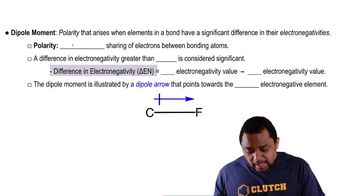Determine the geometry about each interior atom in each molecule and sketch the molecule. (Skeletal structure is indicated in parentheses.) c. H2O2 (HOOH)
Ch.11 - Chemical Bonding II: Molecular Shapes, VSEPR & MO Theory
All textbooks Tro 6th Edition
Tro 6th Edition Ch.11 - Chemical Bonding II: Molecular Shapes, VSEPR & MO Theory
Ch.11 - Chemical Bonding II: Molecular Shapes, VSEPR & MO Theory Problem 47
Problem 47
 Tro 6th Edition
Tro 6th Edition Ch.11 - Chemical Bonding II: Molecular Shapes, VSEPR & MO Theory
Ch.11 - Chemical Bonding II: Molecular Shapes, VSEPR & MO Theory Problem 47
Problem 47Chapter 11, Problem 47
Explain why CO2 and CCl4 are both nonpolar even though they contain polar bonds.
 Verified step by step guidance
Verified step by step guidance1
Identify the molecular geometry of CO2. Carbon dioxide has a linear molecular shape with the carbon atom in the center and oxygen atoms at both ends. The bond angles are 180 degrees.
Analyze the molecular geometry of CCl4. Carbon tetrachloride has a tetrahedral shape with the carbon atom in the center and four chlorine atoms at the corners. The bond angles are approximately 109.5 degrees.
Understand the concept of bond polarity. Both CO2 and CCl4 have polar bonds. In CO2, the difference in electronegativity between carbon and oxygen creates polar bonds. In CCl4, the difference in electronegativity between carbon and chlorine also results in polar bonds.
Examine the symmetry of the molecules. The symmetry of a molecule plays a crucial role in determining its overall polarity. In CO2, the linear shape and equal bond polarities pointing in opposite directions cancel each other out, resulting in a nonpolar molecule. In CCl4, the symmetrical tetrahedral shape with equal bond polarities directed toward the corners of a regular tetrahedron also results in cancellation of dipole moments, making the molecule nonpolar.
Conclude that despite containing polar bonds, the overall molecular polarity of CO2 and CCl4 is determined by their symmetrical geometric shapes, which allow the dipole moments to cancel out, resulting in nonpolar molecules.

Verified video answer for a similar problem:
This video solution was recommended by our tutors as helpful for the problem above.
Video duration:
3mWas this helpful?
Key Concepts
Here are the essential concepts you must grasp in order to answer the question correctly.
Polar and Nonpolar Bonds
A polar bond occurs when there is a significant difference in electronegativity between the two atoms involved, leading to an uneven distribution of electron density. This results in a dipole moment, where one end of the bond is slightly negative and the other slightly positive. Nonpolar bonds, on the other hand, occur between atoms with similar electronegativities, resulting in an even distribution of electron density.
Recommended video:
Guided course

Molecular Polarity
Molecular Geometry
The shape of a molecule, determined by the arrangement of its atoms and the angles between bonds, plays a crucial role in its overall polarity. Even if a molecule contains polar bonds, its geometry can lead to a cancellation of dipole moments. For example, symmetrical molecules like CO2 and CCl4 have their polar bonds arranged in such a way that the dipoles cancel each other out, resulting in a nonpolar molecule.
Recommended video:
Guided course

Molecular Geometry with Two Electron Groups
Dipole Moment Cancellation
Dipole moment cancellation occurs when the individual dipole moments of polar bonds in a molecule are oriented in opposite directions and are equal in magnitude. This results in a net dipole moment of zero, making the molecule nonpolar. In CO2, the linear arrangement allows the dipoles to cancel, while in CCl4, the tetrahedral shape achieves the same effect, despite the presence of polar C-Cl bonds.
Recommended video:
Guided course

Dipole Moment
Related Practice
Textbook Question
Textbook Question
Determine the geometry about each interior atom in each molecule and sketch the molecule. (Skeletal structure is indicated in parentheses.)
a. CH3NH2 (H3CNH2)
b. CH3CO2CH3 (H3CCOOCH3 One O atom attached to 2nd C atom; the other O atom is bonded to the 2nd and 3rd C atom)
Textbook Question
Determine the geometry about each interior atom in each molecule and sketch the molecule. (Skeletal structure is indicated in parentheses.) c. NH2CO2H (H2NCOOH both O atoms attached to C)
Textbook Question
CH3F is a polar molecule, even though the tetrahedral geometry often leads to nonpolar molecules. Explain.
2
views
Textbook Question
Determine whether each molecule in Exercise 35 is polar or nonpolar.
a. CI4
b. NCl3
c. OF2
d. H2S
Textbook Question
Determine whether each molecule in Exercise 36 is polar or nonpolar.
a. CS2
b. SCl2
c. CHF3
d. PF3